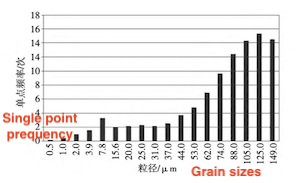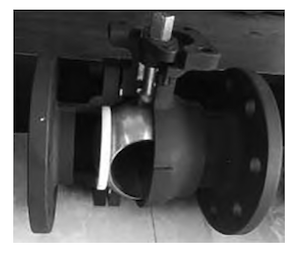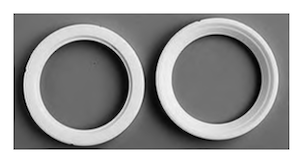Metal Seated Ball Valves in Offshore Platforms (Part One)
Abstract: In the process of offshore oil processing and transportation, leakage prevention has gradually attracted people’s attention. Valves are not only corroded at a much faster rate in the marine environment than inland, but once problems occur, they will cause great economic losses and marine environmental pollution. Therefore, offshore oil engineering has stricter requirements for valve and material selection. Combined with an offshore project, the characteristics and their application of metal seated ball valves in offshore oil engineering are introduced.
Introduction
With the rapid development of China's society, offshore oil exploration projects have now become an important force in driving China's economic growth, and ball valves are also widely used in offshore oil projects. In the marine environment, the corrosion rate of metal components is much higher than inland. Once there is a problem with the valves in offshore oil projects, it will not only cause great economic losses but also cause accidents in the marine environment. Therefore, anti-corrosion issues become another major concern.
A newly built offshore oil field is located in the Liaodong Bay of the Bohai Sea and uses heavy oil thermal recovery development technology. The application of this technology in onshore oil fields is relatively mature, but this is the first large-scale application in offshore oil fields; the technical reserves are very limited. According to the production experience of thermal recovery wells in the Bohai Sea and onshore, there is a risk of sand production in thermal recovery wells in this oilfield during steam stimulation operations. The sand production data provided by the completion professional is that under normal production conditions, the sand content in the produced fluid can reach up to 5t/10,000 cubic meters, and the predicted sand particle size is 0.5 to 149μm. The predicted sand size distribution of thermal production wells is shown in Figure 1.

Figure 1 Predicted distribution of sand sizes of thermal production wells
The heavy oil produced from this oil field has the characteristics of high sand content, severe emulsification, sand-encapsulated oil, and water-encapsulated oil. The current land desanding process requires that the viscosity of the material entering the desander is lower than 700 cP, while the viscosity of the crude oil in this offshore oil field reaches more than 1500 cP. The offshore platform is compact and cannot add facilities before the desander to reduce the viscosity of the crude oil. Therefore, it is difficult to develop a suitable sand removal plan and ensure that downstream valves and pipes are not damaged.
As the most commonly used interception component at sea, ball valve selection and material selection are particularly important for the implementation of this offshore oilfield project. The reliability of valves plays a decisive role in the safe production of enterprises. Therefore, when selecting, careful analysis and research should be based on the specific use environment, medium physical properties and working conditions and appropriate sealing structures and sealing materials should be selected. The sealing must be reliable. It should not affect the production environment and must be economical and reasonable to ensure that the production equipment can operate safely for a long time and bring stable profits to the enterprise. The produced fluid from this offshore oil field contains not only sand but also associated natural gas. It is a harsh working condition with strong corrosiveness, high scourability, and solid-liquid-gas three-phase flow. Therefore, the stricter requirements of the sealing performance and wear resistance of the ball valve have been put forward. Metal seated ball valves attracted special attention from the project team due to their ultra-high wear resistance and superior corrosion resistance. For the marine environment, in addition to wear resistance, corrosion resistance, and high-temperature resistance, higher requirements are put forward for sealing and leakage prevention.
1. Introduction to metal seated ball valves
The sealing of conventional ball valves is achieved by a sealing pair composed of two non-metallic sealing washers and a metallic sphere. The valve stem is rotated by a handwheel, a pneumatic device, or an electric device, and then the valve stem drives the metal sphere to rotate, causing the ball valve to rotate. The metal sphere and two non-metallic sealing washers form a set of rotating sealing pairs to achieve the opening and closing seal of the ball valve (Figure 2 and Figure 3). The metal seat relies on the ball to squeeze the sealing ring, causing deformation in the sealing pair, and the sealing specific pressure is formed due to the deformation and fluid pressure. When the sealing specific pressure is greater than the medium pressure, the metal seated ball valve achieves sealing. Different from conventional ball valves, metal seated ball valves are ball valves in which both sides of the sealing pair are made of metal (Figure 4 and Figure 5). The sealing performance of the metal seat can be enhanced by improving processing accuracy and increasing sealing specific pressure. In addition, spraying, coating and other surface treatment processes are carried out on the body and valve seat of the metal seated ball valve, which can not only improve the wear resistance of the sealing surface of the metal seated ball valve but can also be used in corrosive media. Therefore, metal seated ball valves are often used in environments containing corrosive media or complex working conditions with gas-liquid-solid mixed media.

Figure 2 Conventional seal pairs of ball valves

Figure 3 Conventional sealing gaskets of ball valves
Introduction
With the rapid development of China's society, offshore oil exploration projects have now become an important force in driving China's economic growth, and ball valves are also widely used in offshore oil projects. In the marine environment, the corrosion rate of metal components is much higher than inland. Once there is a problem with the valves in offshore oil projects, it will not only cause great economic losses but also cause accidents in the marine environment. Therefore, anti-corrosion issues become another major concern.
A newly built offshore oil field is located in the Liaodong Bay of the Bohai Sea and uses heavy oil thermal recovery development technology. The application of this technology in onshore oil fields is relatively mature, but this is the first large-scale application in offshore oil fields; the technical reserves are very limited. According to the production experience of thermal recovery wells in the Bohai Sea and onshore, there is a risk of sand production in thermal recovery wells in this oilfield during steam stimulation operations. The sand production data provided by the completion professional is that under normal production conditions, the sand content in the produced fluid can reach up to 5t/10,000 cubic meters, and the predicted sand particle size is 0.5 to 149μm. The predicted sand size distribution of thermal production wells is shown in Figure 1.

Figure 1 Predicted distribution of sand sizes of thermal production wells
The heavy oil produced from this oil field has the characteristics of high sand content, severe emulsification, sand-encapsulated oil, and water-encapsulated oil. The current land desanding process requires that the viscosity of the material entering the desander is lower than 700 cP, while the viscosity of the crude oil in this offshore oil field reaches more than 1500 cP. The offshore platform is compact and cannot add facilities before the desander to reduce the viscosity of the crude oil. Therefore, it is difficult to develop a suitable sand removal plan and ensure that downstream valves and pipes are not damaged.
As the most commonly used interception component at sea, ball valve selection and material selection are particularly important for the implementation of this offshore oilfield project. The reliability of valves plays a decisive role in the safe production of enterprises. Therefore, when selecting, careful analysis and research should be based on the specific use environment, medium physical properties and working conditions and appropriate sealing structures and sealing materials should be selected. The sealing must be reliable. It should not affect the production environment and must be economical and reasonable to ensure that the production equipment can operate safely for a long time and bring stable profits to the enterprise. The produced fluid from this offshore oil field contains not only sand but also associated natural gas. It is a harsh working condition with strong corrosiveness, high scourability, and solid-liquid-gas three-phase flow. Therefore, the stricter requirements of the sealing performance and wear resistance of the ball valve have been put forward. Metal seated ball valves attracted special attention from the project team due to their ultra-high wear resistance and superior corrosion resistance. For the marine environment, in addition to wear resistance, corrosion resistance, and high-temperature resistance, higher requirements are put forward for sealing and leakage prevention.
1. Introduction to metal seated ball valves
The sealing of conventional ball valves is achieved by a sealing pair composed of two non-metallic sealing washers and a metallic sphere. The valve stem is rotated by a handwheel, a pneumatic device, or an electric device, and then the valve stem drives the metal sphere to rotate, causing the ball valve to rotate. The metal sphere and two non-metallic sealing washers form a set of rotating sealing pairs to achieve the opening and closing seal of the ball valve (Figure 2 and Figure 3). The metal seat relies on the ball to squeeze the sealing ring, causing deformation in the sealing pair, and the sealing specific pressure is formed due to the deformation and fluid pressure. When the sealing specific pressure is greater than the medium pressure, the metal seated ball valve achieves sealing. Different from conventional ball valves, metal seated ball valves are ball valves in which both sides of the sealing pair are made of metal (Figure 4 and Figure 5). The sealing performance of the metal seat can be enhanced by improving processing accuracy and increasing sealing specific pressure. In addition, spraying, coating and other surface treatment processes are carried out on the body and valve seat of the metal seated ball valve, which can not only improve the wear resistance of the sealing surface of the metal seated ball valve but can also be used in corrosive media. Therefore, metal seated ball valves are often used in environments containing corrosive media or complex working conditions with gas-liquid-solid mixed media.

Figure 2 Conventional seal pairs of ball valves

Figure 3 Conventional sealing gaskets of ball valves
Previous: Fire Resistance Testing Equipment for Pipes and Valves
Next: Metal Seated Ball Valves in Offshore Platforms (Part Two)
Next: Metal Seated Ball Valves in Offshore Platforms (Part Two)




